Day 1: Halle→Dresden (Germany) → Prague (Czech Rep.)
It's time again to hit the road, but this time, all we've got is two weeks. And it's the first chance to visit Romania. I've been to almost all countries around Romania several times, but this big, mysterious country in the mountains remained a white spot on my travel map. By this chance, we also planned to travel the Republic of Moldova - a country we seldomly hear of. A friend of a friend of a friend or something like this lives there, so we've even got a place to stay. As usual, we wanted to discover the area mainly by train, though it's quite an expensive pleasure to go to Romania from Germany if you haven't got the time to jump from border to border. There is no discount ticket, so we had to pay € 145 for a seat in the sleeper from Halle to Brasov in Transylvania. One way, of course.
There is no longer a direct train from Germany to Romania. Therefore, we first had to go to Dresden in the early afternoon and then jumped on the train to Prague. Although the train had had a substantial delay, we arrived early enough in Prague hl. n. to catch the next train.
Relevant links: →Czech Republic | →Prague
Day 2: Prague → Brasov (Romania)
Fortunately we had enough time to grab some food before we entered the train, which was supposed to leave shortly before midnight. "Budapest" is written on the carriages, and all numbers are completely chaotic. Only one carriage is bound for Varna in Bulgaria, and that's the one we are looking for. According to Murphy's law, our carriage has to be the very last one. Indeed it is at the very end of the long train. There are four berths in every compartment and already two huge Czech hikers sitting in ours. The sleeper is quite old but clean and far from being booked out.
We wake up in Budapest at around 8 am and dimly recall a few border controls during the night.
After the train got rearranged, we continued towards the Romanian border. Most carriages are now bound for
Bucarest. I decided to go for a coffee. But our conductor is sound asleep. The next carriage is from Slovakia and
the price for a coffee € 0.4, but there seems to be no conductor. Next carriage - that's a Hungarian one and there
they charge 1 Euro for a coffee. In our Czech carriage, it's € 0.8. That's what I call an interesting pricing system. Whole
Europe in one train. In a German train, it would be € 2.6 for a lousy cup of coffee.
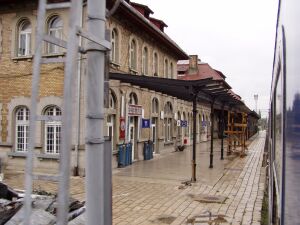
| ||
| Romania - the very first impression |
The resistance of water is higher than the resistance of air, and so it took much longer than planned for the train to
arrive in rainy Brasov. It's already past 9 pm, so the tourist information is closed. An older couple approached
professionally and showed us some references in various guidebooks. Maria and Greg - we had read about them and were
not surprised to meet them at the station. Maria mixed English with Japanese, some Romanian and German, though.
One thing we learned within a second is that she's extremely talkative. We listened to her offer and tried to filter out the
relevant information. 10 Euro per night and person in an appartment. Sounds good. Yes, we want to see it before we move in.
Yes, Romania is nice - except for the rain and the butcher in the train. No, our trip is not limited to Romania. What, Moldova
is so far away!? Naa, we just came from Japan and Germany, that's far! Maria even started to calculate and to tell me,
how much money I should withdraw. Yes, mum. Yes, we are careful when going out at night. Thanks for not imposing a curfew!
She is really nice, but I couldn't stand her for more than an hour. Before following her, I withdrew 4 Million Lei. Now, that's a nice
number!
After a short ride in their car and a lot of talk, we arrived at the appartment. It's spotless clean and nice, indeed.
Bathroom and kitchen - everything's there. And we got our own key. After paying, Maria and Greg disappeared and it became
extraordinarely quiet. Out in the rain, looking for proper food. All we can find is a Turkish restaurant, serving
fresh and yummy lahmacun, one of my favourites. I can't remember that I had a better lahmacun in Turkey.
Together with some beer, we only pay around € 3. A hot shower after one and a half day in a train is always
a pleasure. And we find out, that we are not alone - a Scottishglish and a Dutch couple got caught by Maria, too.
Relevant links: →Czech Rep. | →Prague | →Romania | →Brasov
Day 3: Brasov (Kronstadt) → Bran → Rasnov → Brasov
After a cup of instant coffeee we got started. Today, we wanted to visit the famous castles of Bran and Rasnov. Maria offered us to join a tour group. which would have set us back € 5. Which is not much, but we still prefer to do it our way. The Scottish accepted Maria's offer and left at the same time. It was still raining and rather cold, and it took a while to find the bus terminal. After a short bus ride we arrived at the so called Dracula castle in Bran. What a disappointment - the castle looks like Disneyland and is historically not interesting at all. Nevertheless it's full of tour groups. Inside the castle we met our Scottish travellers again.
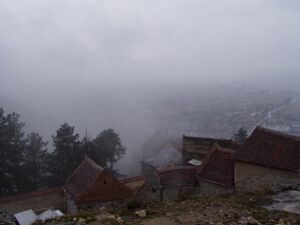
| ||
| What is supposed to be a great view... |
Soaked to the skin, we went for a warm meal to a small restaurant called "Intim". Strange name, but it's really a restaurant
and the food is alright. After that, we took a bus back to Brasov, where we were quite surprised. Until then, we thought
that the rain couldn't get stronger, but this proved to be wrong. The streets started to swim, and so we decided that
taking a taxi might not be such a bad idea after all. A taxi is a good place to get ripped-off. According to rumours, Romania
is also a good place to get ripped-off. So what about a Romanian taxi? The one we've stopped didn't have a meter.
When we arrived, I asked for the fare and the driver simply shrugged his shoulders. Wow, that's nice! I handed over € 0.60 or so
for around three kilometers and he said "thanks, have a nice day!"
Despite the rain we walked around the old city center of Brasov. It looks pretty much like a German town and is quite attractive.
After sunset, we entered a restaurant in an ugly concrete building. The restaurant looked cheap from the outside and
expensive from inside. But the food was worse than the impression from the outside. Greasy, flabby fried meat and chips. At least,
prices were adapted to the impression from the inside. What a day.
Day 4: Brasov (Kronstadt) → Bucharest

| ||
| Pure traffic chaos in Bucharest |
I tried to find one single word to describe Romania's capital. Chaos. Yes, that's it. Especially the traffic is deadly. Even worse than in Bangkok or Cairo. Maybe it's because it's raining, but I don't like this city. At night, this impression didn't improve. Glue-sniffing youths lurking around the hotel and the train station do not really invite to a stroll at night. At the reception we asked about any recommendable eateries around the hotel just to find out, that there's nothing. But there's a restaurant in the hotel next door. Romanian beer? No, but we have small bottles of Heineken for € 2 only! And lousy food. Well, it's nice to stay in a conveniently located hotel right next to the train station, but in Bucharest it's not the best idea.
Relevant links: →Romania | →Sinaia | →Bucharest
Day 5: Bucharest
At least it wasn't raining anymore this morning. So we walked to the Moldovian Consulate to arrange our visa. A policeman was standing in front of the Consulate. I tried to say in Romanian that we want to get in. He seemed to be in a bad mood and snarled "Can't you ask properly!? In English? I speak English, man!" Well, there were many symbols on his uniform, so "I couldn't spot one that says: I speak English" This is what I told him, and now he was really pissed. He told us to wait since there is still someone inside. Because we didn't know whether we have to pay the visa fee in Romanian Lei or in Euro, we decided to look for an ATM first. When we came back, the guard let us in immediately. According to the Internet, neither Japanese nor Germans need to obtain special documents to get a visa, i.e. money + passport = visa. No way! The consul checked my passport and gave me his o.k., then he checked my fellow travellers passport and said "Where is your Letter of Invatation? No LOI, no visa!". Might the country be oh so poor, the visa regulations are tough, that's sure! I tried to convince him - after all the number of Japanese tourists would almost double (which of course I didn't tell him), but there's no way. I wonder if a bribe would work, but I'm allergic to bribes. I asked if a fax from the inviting person would be alright, and he nodded.
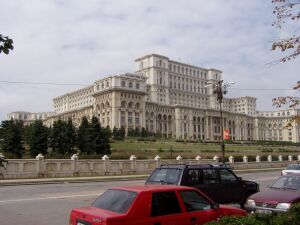
| ||
| Ceausescu's petrified megalomania |
What to do now. All we wanted is to get out of this city. The weather was still bad in the mountains, and there will be another chance to visit Romania, that's for sure. At least when we try again to go to Moldova. But I wanted to see something new. Bulgaria? Nice, but I've been there four times already. Serbia? Don't they have wicked visa regulations as well? Turkey? Too far away to get back in time, and we've been there the last year. I checked the map again and discovered the small country Macedonia. I knew where it is but never had had the idea to go there. To go there, we had to cross Bulgaria. After getting train tickets to the border town of Giurgiu, we walked around the city. The giant House of the People. The Piata Unirii. Alas, what has Ceausescu done to this city!? A nightmare in concrete. The remaining part of the old city has a certain charme, indeed. But it's chaotic as well. There is a lot of construction work going on. Maybe Bucharest will be a nice place - but not in the very near future. At night, we took the subway to the centre to find a good place to eat. And we found one - although it's quite expensive to eat out in central Bucharest.
Relevant links: →Romania | →Bucharest
Day 6: Bucharest → Giurgiu → Ruse (Bulgaria)
We walked to the Basarab train station (what a coincidence - Basarab is the old name for Moldova) in a run-down living quarter. There we jumped on a local train to Videle. In Videle, we changed the train to get to Giurgiu at the Romanian-Bulgarian border. We arrived there at about 10:30 a.m.. Giurgiu's northern train station is in the middle of nowhere, and the next train crossing the border leaves at 2:30 p.m. In an old, shabby cafe with a bunch of definitely not trustworthy men we asked, how far the border checkpoint is. They discussed the question for a while (can I call a friend!?) and decided, that it's 3 km. Oh, 3 km sounds good! And so we walked. All along the railway tracks. Somewhere, the tracks parted. That's tricky! To be sure, we asked a little boy feeding the family's cow where Bulgaria is, but he didn't have the slightest clue what or where Bulgaria is. We could see some chimneys on the left side, so we decided that going left might lead us to our goal.
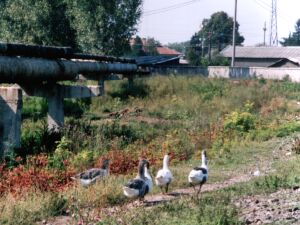
| ||
| Are you sure that there's a border around here!? |
To enter Bulgaria was no problem at all. The border guard asked "Where are you coming from right now?", and I replied "From Romania". A few minutes later, I wondered why the guard didn't react on that. When crossing the Romanian-Bulgarian border, it's quite obvious that the traveller comes from Romania. However, stupid questions require stupid answers. A very annoying taxi driver approached immediately. But we went back to change some money. We got stopped by a fat, sweating man explaining, that the exchange rate at the border is very bad. And he's right. He's looking at my girlfriend and says in perfect German "You know what, your girlfriend looks worn out!". A short look, and all I can do is to agree. Next he asked where we were heading to. "Ruse" I said. "Do you have one Euro" he asked, and after handing over one Euro, he gave us two Leva, which is more than fair and more than enough for the bus to Ruse. The annoying taxi driver looked a bit disappointed. Actually we wanted to head to Veliko Tarnovo, which is one of my favourite spots in the area. But when we arrived in Ruse, it was already too late to be in Tarnovo before sundown. We found a nice cafe on the nice central place of Ruse, where we could eat breakfast and lunch at the same time and have a cold, refreshing Zagorka for a welcome. Thanks to a local travel agent, we soon got a private room. It's my fifth time in Bulgaria, so I almost felt like being home. However, people are friendlier then years before. At least this was my impression. And it's still the cheapest place in the whole area.
Day 7: Ruse → Sofia
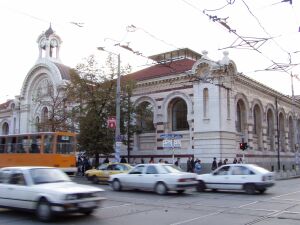
| ||
| Booming Sofia |
To find a hotel in Sofia is no problem at all. After searching for a while, we even found a money exchange, where we could get rid of our Romanian money, which was supposed to be the Moldovian visa fee. The weather was nice and Sofia had changed a lot. Recently it got nicer and more attractive - compared to the situation a couple of years ago. In the evening we relaxed in the courtyard of the hotel, but not for long. One walnut after the other fell off the tree and crashed on the tables and the ground and everywhere. Quite a thrill to keep sitting.
Day 8: Sofia → Skopje (Macedonia)
It looks like there are only two busses a day to Skopje - one in the early morning and one in the afternoon. To have some time when arrived in Skopje, we took the one in the morning and got up at 6 a.m. It was still dark outside. The bus started on time and stopped at a small cafe after one hour - the perfect place to have nice cup of coffee.
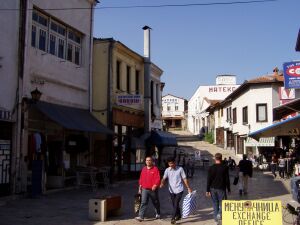
| ||
| Little Istanbul in the middle of Europe |
Macedonia - that's mountains. Along the road, almost unreadable, partially bullet-hit road signs. At 1 p.m., in the heat of the day, we arrived in Skopje. From the very beginning we thought, that this place is completely different to Bulgarian cities. It's more chaos, more genuine, more oriental. To put it in one word - more Balkan. After changing some money, we had lunch in a small and modern restaurant. Quite expensive. We checked in at the youth hostel. Expensive, too. An extensive walk through the city showed us, that Skopje is a typical earthquake city. After a devastating tremor, a new ugly city centre had been created. But the old fortress and the bazaar-like Turkish quarter on the other side of the river are great and let the visitor forget that he's in Europe. In the evening, we went for a dinner in a popular, noisy restaurant near the youth hostel. How exciting - it's grilled meat again!
Relevant links: →Bulgaria | →Sofia | →Macedonia | →Skopje
Day 9: Skopje → Ohrid
Skopje is interesting, but not worth staying there for a couple of days. At least it's just another big city. And it's surprisingly expensive - I've got the feeling that I have to withdraw money once in six hours. That's why we took a bus to the famous lake Ohrid. At the bus terminal, a fat old man approached and asked for our intentions. He showed us around and brought us to the ticket counter. He was quite nice, but what was his intention!? He told us, that we might sit down for a coffee because we have much time. I offered him a coffee as well, but he refused. Instead of having a coffee, he started to talk about his poor old wife. And his boy, who is in need of a surgery. And so on. This was how the wind blows. Must be tough life. "Yes,", he said, "but what are you going to do to help it". What a strange way to ask for money! Might the story be true or not, I gave him some denars to get rid of him. I don't like this "May I help you? .... Give me money!" method.
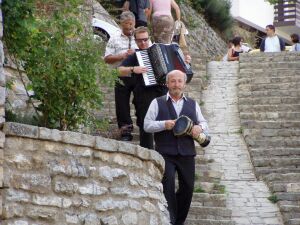
| ||
| Music's in the air in Ohrid |
A walk in Ohrid is a great thing. The old city is as nice as the surrounding. No wonder this place is famous and popular among tourists. But it's September, so there aren't many tourists around. A Macedonian asked " Why are you here at this time of the year! There are no tourists around! That's boring, isn't it?". Not at all! Indeed, it's much better to visit Ohrid off-season. But there were still enough people around. While watching the sunset over the beautiful lake, a boat full of shouting and screaming tourists churned up the quiet lake and eliminated the last romantic feeling.
Relevant links: →Macedonia | →Ohrid | →Skopje
Day 10: Ohrid → Sveti Naum → Ohrid → Skopje
In the morning we took an old shabby bus to the South shore of the lake, to a place called Sveti Naum. The bus first stopped at Sv. Naum, then went on to the Albanian border. I thought that the bus would return to Sv. Naum, but that was not the case. It would set us back around € 50 to cross the border, but we didn't have much time and our luggage was in Ohrid. "I'll be back" I muttered towards the border, and we walked down the road back to Sv. Naum, where a nice monastery awaits the visitors. After walking around, we moved back to Ohrid to have lunch, and then returned to Skopje. We wanted to take the night train to Belgrade, and so we had a lot of time left to stroll around the entire old city.

| ||
| Pogradec in Albanien |
The train from Thessaloniki arrived almost in time. And there were almost no passengers. The conductor of the sleeper was a chain-smoking Serb, and he was really funny. The two of us got a compartment with four berths which we didn't have to share with other passengers. After two hours, we arrived at the Serbian border. The border guard was quite rude and started a short quiz - "Where to?" - "Belgrade". "Why?" - "sightseeing" - "why Serbia?" - "..." But the grill was over after five minutes, and so we entered infamous Serbia for the first time.
Relevant links: →Macedonia | →Ohrid | →Sveti Naum | →Skopje | →Albania
Day 11: Skopje → Belgrade
The night in the train was relaxing and one of the best night train rides I've ever had. At 7:30 in the morning we arrived in Belgrade. "This is not the Balkans!" was my first thought when I stepped out the train station. It rather looks like a typical central European or Western city. After a cup of coffee we went on to look for a reasonable hotel. The first one was booked out.
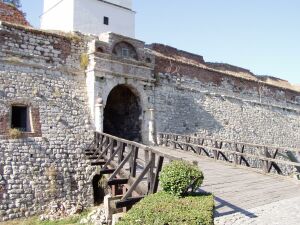
| ||
| The Belgrade fortress Kalemegdan |
It took a while to find the war museum. From outside we could hear war songs, and they weren't from tape but live. A huge guy approached quickly and told us in a hostile manner, that the museum would be closed to the public today. What a pity. Before the entrance we saw a badly damaged hummvee - probably captured from U.S. soldiers after an obviously tough fight. When we walked back home, we came across two heavily damaged buildings. Relicts of the NATO air raid marathon. Besides that, it was hard to believe that this town was a war scene just a few years ago.
At night we had dinner in a restaurant near the hotel. Staff was really friendly, and the food, although fried meat again, very good. Vegetarians really must have a hard life on the Balkans...
Relevant links: →Macedonia | →Skopje | →Serbia | →Belgrade
Day 12: Belgrade → Novi Sad
This trip is far away from being a holiday. Our original plan to visit Moldova would have given us plenty of time to stay at the same place for more then one or two days. But our alternative route is much longer and lets us rush through the area. Which is still interesting, since it gives us the chance to capture an instant picture of a great part of the Balkans. And we get an idea , which country is definitely worth another, more extensive visit. This day, it's only two hours on the train. In the morning, we took a local train to go to Novi Sad in Northern Serbia, a traditionally Hungarian influenced region called Vojvodina. When we arrived in Novi Sad, we puzzled about whether to continue to Hungary to have a few quiet days there or to stay in Novi Sad. But Novi Sad ought to be interesting, too, and so we took the bus to the centre.
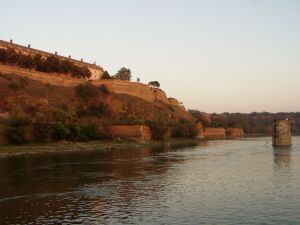
| ||
| Fortress and the remainings of the bridge in Novi Sad |
In the evening we agreed that we had had enough of grilled meat. We felt like each of us already had an entire pig and a complete cow during this trip. So we sat down in an Italian restaurant to have some Carpaccio and Pasta. It was pretty authentic - we should have done this much earlier.
Day 13: Novi Sad → Györ (Hungary)
In the very last minute we caught the train to Hungary. For some reason there was suddenly no bus at
all to the train station so that we almost missed it. This would have caused a bigger financial problem. There were
almost no people at all in the train - except for the compartment our reserved seats where in. Why did we reserve a seat anyway!?
We went to a completely empty carriage. The Hungarian border was quite close. Hungarian border police armed with
drills and everything entered the train and immediately started to dismantle parts of it. Which was quite strange - no
passengers, no smugglers!
Because of our rush in the morning we hadn't had time to buy some food in the station. And so we went to the restaurant carriage.
It was an Austrian one, which means Austrian food and Austrian prices. Austrian food, that's veal schnitzel. After we ordered, we
heard the chef soften the meat with a hammer, making the crumb with fresh eggs and so on. Amazing - in German trains
all you get is lousy food from the microwave. For the same price, of course.
Soon after arriving in Hungary it started raining. The train stopped in Budapest, but we preferred to stay in a smaller
city we haven't been to yet. That's why we went on to Györ West of Budapest. There we arrived around 5 p.m.
The hotel managed by the railway company wasn't very beautiful but okay for a night and quite cheap. Before sunset we tried to
see as much as possible. It's a nice old town with an intact medieval city centre, which is lovely restored.
At night we ate out in a restaurant and suddenly heard German everywhere. The restaurant was full of Austrians jumping the border
for a cheap dinner. Some of them behaved in an unexcusable way, discussed the bill without using a single word in Hungarian and
making fun of the poor staff. At least it's not only the Germans acting that way. We said "thank you" in Hungarian to the waiter
and suddenly he became very friendly. Again we could confirm the fact, that whereever you go in Hungary, the food is great.
Day 14: Györ → Tábor (Czech Rep.)
Unfortunately it's not easy to get from Györ to neighbouring Slovakia or Czech Republic. The easiest way is to go via Vienna. This took two hours with a local train. There they told us that we would have to go to the train station at the other side of town. This is best done by tram. And so we got the chance to see magnificant Vienna in a blink of an eye. I've crossed Austria so many times but never had to chance to see the capital. Although simply crisscrossing Vienna by tram doesn't really count as "been there, seen that". Still, Vienna is really impressive - that's what we understood from our tramride. I presume, it takes more than a week to get an idea of the town.
Next to the Franz-Joseph train station is a modern Japanese resutarant called "Akakiko". What a stupid name - it's all but Japanese! But we were curioused and stepped in. Soon we were surrounded by quite annoying staff from China!? Vietnam? Lots of businessman sat there and enjoyed their Sushi, which didn't look very tasty. I've never seen such an un-Japanese Sushi bar before.
I did the typical German mistake to try to order a coffee (in German: Kaffee). Coffee!? Please specify! Do you want a long one? Or a short one? Melange? Didn't know so far that one needs to be a scientist to order a simple cup of coffee. The next train took us to Gmünd in Lower Austria, where we changed the train to cross the Czech border. Fifth time this year in the Czech Republic. Isn't there a frequent traveller bonus program or something!? We decided to stay in Jan Hus' city Tabor. After a long walk we entered the old city centre and soon found a very nice pension. The medieval city is like stepping back in time. We finished the evening with a huge Czech style supper - a nice way to finish this trip.
Relevant links: →Czech Rep. | →Tábor | →Hungary | →Györ
Day 15: Tábor → Halle (Germany)
In the morning we moved to Prague, just to continue to Dresden/Germany. Except for the first three days, we never had a delay. But now we entered the territory of the German railway company, called Die Bahn, again and the odyssey started. There ought to be an ICE (bullet train) from Dresden to Leipzig. In Leipzig, we were supposed to have 20 min time before the next train starts to Halle. Due to technical problems, there would be a 30 minutes delay the announcement said. The train was already in the station. Inside, it was extremely dirty - what about using the delay to clean up the mess!? When we arrived in Leipzig, our train had already gone. And it was pure chaos in the huge terminal - spontaneous changes of the departure time and the platforms made it virtually impossible to find the correct train. To be German didn't help at all - we entered a train at a platform with "Halle" written at the display. After some 20 minutes ride, the conductor checked our tickets and asked "Now how do you want to go to Halle!? You're on the wrong train!" Great. So we had to get off the train at the next stop, wait for more than one hour and jump on the next train bound for Halle. There we arrived with a 2½ hour delay. What a shame.
P.S. - One year later we gave it another try and finally managed to go to Moldova.
Relevant links: →Czech Rep. | →Tábor | →Halle (Japanese only)
©2024 Europe-East.com

 Albania
Albania Travelogue Index
Travelogue Index